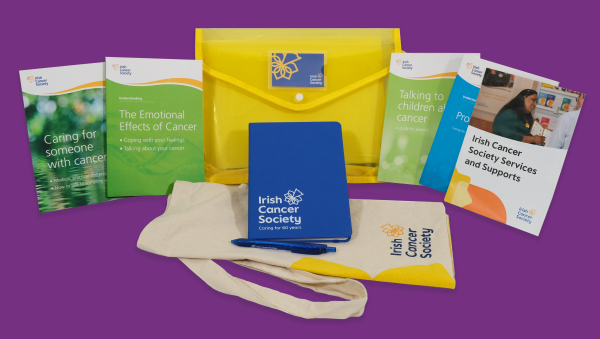Acute myeloid leukaemia (AML)
Diagnosis and tests
Diagnosing AML
Your family doctor (GP) will talk to you about your symptoms and arrange blood tests, if needed. If your blood test is abnormal you will be referred to hospital for more tests. Tests you might have include:
Listening to your chest, feeling your abdomen, asking questions about how you have been feeling recently.
For example, a full blood count. This finds out the levels of the different types of blood cells in your blood. Your blood will also be examined under a microscope, as leukaemia cells can sometimes be seen and the diagnosis confirmed.
Taking a sample of the fluid that surrounds your brain and spinal cord using a needle in your lower back. The fluid will be checked for cancer cells.
Read more about lumbar punctures.
If you are diagnosed with AML we're here for you.
Our cancer nurses are here if you need information or just want to talk. They can help you to understand your diagnosis and what to expect, send you information and tell you about our services.
Further tests for AML
You may need further tests to give your doctors more information about your general health and about the cancer. For example:
As well as a full blood count (FBC), blood tests can also check how well your liver and kidneys are working. Your blood will also be screened for any infections, such as hepatitis and HIV, to make sure any treatment planned is safe for you.
Blood film
Your doctor may look at a blood sample under a microscope in order to determine the amount of leukaemia cells present. This is often called a blood film and is usually carried out in the haematology laboratory of the hospital.
Taking a tiny sample (biopsy) of your bone marrow and looking at it under a microscope to examine the cells there.
Read more about bone marrow biopsies.
Immunophenotyping checks what kind of proteins or markers are on the surface of your leukaemia cells. Immunophenotyping can be used to determine what type of leukaemia you have. It can also help monitor your response after treatment. It can be performed on both a solid sample of your bone marrow (immunohistochemistry) and a liquid sample (flow cytometry).
Flow cytometry is the main type of immunophenotyping used to diagnose and monitor AML. It measures the number and percentage of different cells in a blood or bone marrow sample. It also measures cell characteristics such as size, shape and the presence of proteins (biomarkers) on the cell surface. Cells are passed through a machine call a flow cytometer. This can be used for diagnosis or to check how you are responding to treatment.
Genetic testing is the main tool used by doctors to classify AML into type and risk categories. It helps them to choose the best treatment for your disease and monitor your response to treatment.
Almost all AML patients will have some genetic abnormalities detectable in their leukaemia cells. These gene changes/faults are generally not the same as genes passed through families and are only present in the leukaemia cells.
If a gene that can be inherited was detected in your AML cells, your doctor may discuss doing further tests into you and your direct family members, with their consent.
With AML, there may be some particular genetic changes in the leukaemia cells. Knowing about these changes will help your doctor to decide on the best treatment for you.
Chromosome tests can find out the number and shape of the chromosomes in your blood cells. Chromosomes are made up of genes that control the activities of cells. Tests can be done on your blood and/or bone marrow samples. These chromosomes are then compared to normal cells.
Fluorescent in situ hybridisation (FISH) makes abnormal genes glow (fluoresce) so that the doctor can identify the particular type of genetic abnormality. A FISH test can help your doctor predict how your leukaemia might respond to a particular treatment. They can use this information to recommend the best option for you.
This is a very sensitive test that can find even low levels of leukaemia cells in a test sample. It can find small levels of chromosome changes that other tests cannot find. The results of PCR tests are relatively fast to obtain. For these reasons, the test is often used to look for some particular genetic abnormalities that can change your initial treatment. They are also used to monitor the response of your disease to treatment. The PCR test can only look at a particular abnormality in one selected gene
NGS allows doctors to analyse multiple genetic changes in leukaemia cells. By identifying specific genetic alterations, NGS helps confirm the diagnosis of AML, predicts how aggressive the leukaemia might be and guides treatment decisions. NGS can also uncover mutations that indicate how well a patient might respond to certain therapies. This helps to personalise treatment plans and improve outcomes. Unlike PCR, NGS is used to look at multiple genes at the same time. However, there is more work involved in this and results might take longer to come back.
Ultrasound uses sound waves to produce pictures of the inside of your body. It only takes a few minutes and does not hurt. Ultrasound can be used to look at lymph nodes near the surface of the body. It can also be used to look inside your abdomen for enlarged lymph nodes or enlarged organs such as the liver, spleen and kidneys. You may also have an echocardiogram (echo), which is an ultrasound of your heart. This can check your heart health and help your doctor to decide if intensive treatment may be suitable for you.
Read more about ultrasound scans.
A scan that uses magnetic energy to build up a picture of the tissues inside your body. Read more about MRI scans.
A type of X-ray that gives a detailed picture of the tissues inside your body.
Read more about CT scans.
The tests you have can:
- Show the extent of your leukaemia and the type of leukaemia you have.
- Help your doctor to predict how your leukaemia might respond to a particular treatment and to decide on the best treatment for you.
Some tests may be used see how you are responding to treatment.
Waiting for test results
It usually takes 1-2 weeks for most of the test results to come back. Waiting for results can be an anxious time. It may help to talk things over with your doctor or nurse or with a relative or close friend. You can also call our Support Line on 1800 200 700 or visit a Daffodil Centre to speak to a cancer nurse.
Occasionally, some genetic tests might take 4-5 weeks to come back. If you need to start treatment before these results are available, your doctor will decide on your initial treatment without delay.
Continue reading about acute myeloid leukaemia (AML)




Get help and support

Support Line
Free support pack

